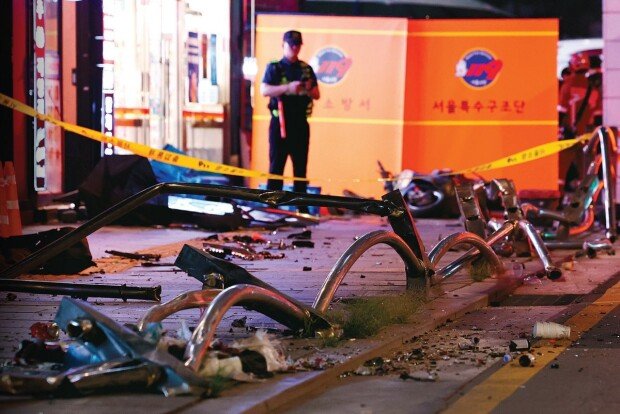Guardrails at tragedy site did not protect citizens
Guardrails at tragedy site did not protect citizens
Posted July. 04, 2024 08:22,
Updated July. 04, 2024 08:22

It has been confirmed that the protective fences (guardrails) on the sidewalk seen between the victims and the vehicle that violated one-way traffic rules in the tragic accident at Seoul City Hall Station on Monday were not installed to protect pedestrians from vehicle accidents. They were simply there to prevent jaywalking and bicycle falls. Due to weak performance standards, the fences were never meant to protect pedestrians in the first place.
According to Seoul's Jung-gu Ward Office on Wednesday, the guardrail was installed in 2012. According to the current law, guardrails are classified according to the purposes into 'vehicle protection' and 'pedestrian protection.' Those installed at intersections, highways, etc., are for vehicle protection. They are subjected to vehicle crash tests and must meet certain performance standards. On the other hand, pedestrian barriers installed on sidewalks, such as the one at the site of the accident in the City Hall area, do not undergo vehicle crash performance tests. This is because they are merely designed to prevent pedestrians from jaywalking and bicyclists from falling onto the road. The top of the guardrail is only required to withstand a load of 10 kilograms per meter, and the side of the guardrail is only required to withstand a load of 37 kilograms per meter. Closed-circuit TV footage from the scene shows that the driver quickly smashed through the guardrail and plowed into the crowd.
For this reason, experts have pointed out that a stronger guardrail could have reduced the damage. Cho Joon-han, a senior researcher at the Samsung Traffic Safety Research Institute, said, "The pedestrian guardrail at the accident site is bound to bend easily when a car hits it. The durability standards should be strengthened to withstand the impact of a vehicle running at least 30 kilometers per hour."
이채완 chaewani@donga.com







